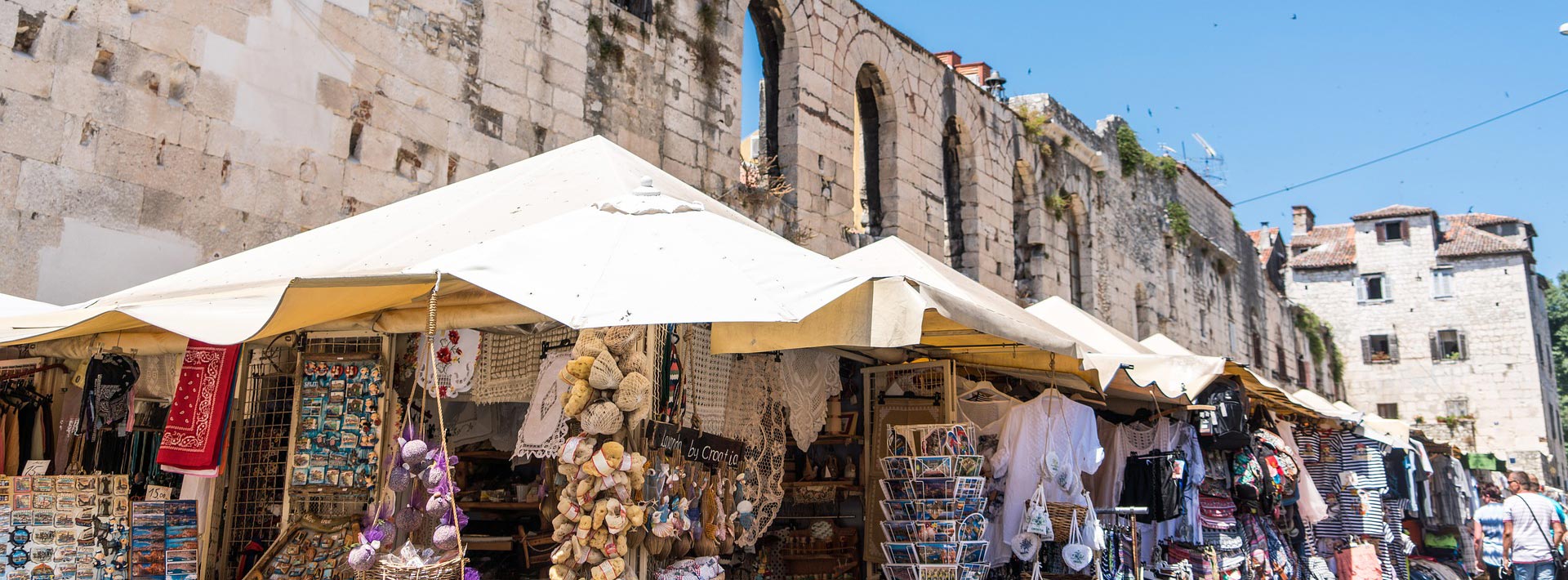SPLIT TOURIST ATTRACTIONS: AN ULTIMATE GUIDE FOR TOURISTS IN SPLIT
Although Split is Croatia’s tourism capital and the country’s second largest city, it is small enough to be explored by foot and its coastal position makes it ideal for offshore discoveries as well. We have rounded up the ultimate attractions that tourists should not miss; within the palace, outside the palace walls, and beyond the pristine coastline.
IN DIOCLETIAN’S PALACE
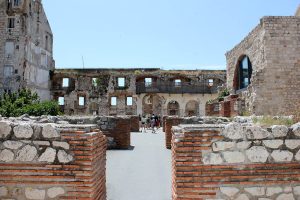 Split’s urban center is a magnificent seafront palace built by Roman Emperor Diocletian over 1700 years ago who moved from nearby Salona to retire on the coast. The 160 meter by 190 meter fortified structure is today the nucleus and lifeline of Split where some 3000 people live within the walls of the palace, shops thrive, and restaurants are bustling. Every corner tells new stories and here we reveal the most compelling to be explored.
Split’s urban center is a magnificent seafront palace built by Roman Emperor Diocletian over 1700 years ago who moved from nearby Salona to retire on the coast. The 160 meter by 190 meter fortified structure is today the nucleus and lifeline of Split where some 3000 people live within the walls of the palace, shops thrive, and restaurants are bustling. Every corner tells new stories and here we reveal the most compelling to be explored.
Before entering the Golden Gate along the palace’s northern wall, you will be greeted by the statue of Grgur Ninski (Gregory of Nin), a 10th century Croatian bishop from Nin. The giant statue is a famed for his toe, which has been rubbed golden as it is believed that touching it and making a wish brings good fortune.
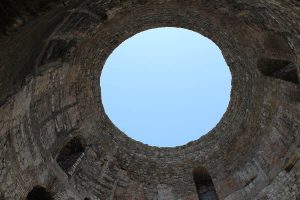 As you enter the palace, continue south to Peristil, the imperial square that separated the emperor’s residence from that of the servants and soldiers. From the Protyron on the southern side, Diocletian would address his people on the square before returning to his residence through the Vestibul circular foyer, today a popular spot for local klapa a’capella performances.
As you enter the palace, continue south to Peristil, the imperial square that separated the emperor’s residence from that of the servants and soldiers. From the Protyron on the southern side, Diocletian would address his people on the square before returning to his residence through the Vestibul circular foyer, today a popular spot for local klapa a’capella performances.
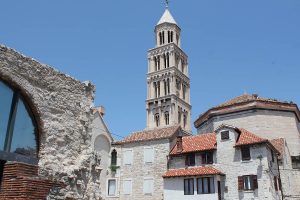 Beyond the eastern colonnade is Split’s city landmark, the 13th century Romanesque bell-tower that belongs to the adjoining octagonal Cathedral of St. Domnius (Sv. Duje), housed in what was formerly Diocletian’s mausoleum; quite ironic considering the emperor was a persecutor of Christians. Visitors can climb the tower for 360-degree city views, take a stroll through the cathedral and see the impressively preserved domed interior, and enter the treasury exhibiting sacral artwork dating back to the 6th century.
Beyond the eastern colonnade is Split’s city landmark, the 13th century Romanesque bell-tower that belongs to the adjoining octagonal Cathedral of St. Domnius (Sv. Duje), housed in what was formerly Diocletian’s mausoleum; quite ironic considering the emperor was a persecutor of Christians. Visitors can climb the tower for 360-degree city views, take a stroll through the cathedral and see the impressively preserved domed interior, and enter the treasury exhibiting sacral artwork dating back to the 6th century.
Along the eastern colonnade of Peristil is a dark passageway that leads you to the Temple of Jupiter, with a beautiful vaulted ceiling. To exit the palace onto the Riva seafront, walk through the dungeon-like basement halls accessible from Peristil.
Top Attraction in Split
A visit to Split is not really a visit without meandering through the narrow lanes of the 1700-year-old palace. The fortified palace has a heap of sightseeing attractions and to see the entire palace at one glance, climb up the 57-meter tall Romanesque bell-tower of the Cathedral of St. Duje.
At the top of the 13th century belfry, you can enjoy 360-degree views of Split. Once you get down, you will be back on Peristil, an imperial square, framed by a colonnade on two sides where sitting on the ancient steps and watching local life pass by is simply priceless.
Grab a spot in the morning when a local klapa a’capella band sings in the Vestibul circular foyer nearby.
Explore the Imperial Fortress
In the heart of modern city of Split stands a 1700 year old Palace. We take you through all it’s major attractions and not to miss sights revealing interesting history behind them.
Top Attractions of Diocletian's Palace
Cathedral of St Domnius
Cathedral of St. Domnius is the second oldest structure in the world which is in function as the Christian cathedral, and is regarded as the the oldest Catholic cathedral which remains in use in its original structure, in the entire world.
Relax on the Emperor Square
When you step on the polished stones of the Peristyle, it’s easy to imagine how Diocletian entered with his imperial garments and walked among the cheering crowd.
Under the Sky
In the Roman world, the emperor had a divine origin. In fact, he was the son of Jupiter, the king of the gods. The role of the vestibule was to reinstate this.
Discover Imperial Mausoleum
Diocletian’s mausoleum is part of the emperor’s palatial complex in the heart of Split, Croatia. The building, which was constructed at the run of the 4th century AD, is still in use today.
Enter the Underworld
They are situated right under the emperor’s quarters and are basically designed as their mirror image. The mirrored floor-plan is not an aesthetic solution, but a practical one as the cellar’s walls, columns and archers support the structure above.
Ancient Temple of Split
Historians have dated the building of the Temple of Jupiter between 295 and 305 AD. It was built as part of the imperial palace’s complex right across the mausoleum – the final resting place of Diocletian.
Touch the finger for good luck!
The statue was initially erected in the Peristyle of Diocletian’s Palace, a place truly worthy of such an important figure in Croatian history.
Beauty of Croatian Culture & History
It is considered to be one of the most beautiful not only in the city, but in the entire region because of the splendid Baroque architecture of the buildings that surround it.
BEYOND THE PALACE WALLS
As life became too crowded in the palace, development spread beyond the western walls in the 14th century. As you exit the palace through the Iron Gate, you will step onto the ancient Pjaca Square (formally known as Narodni trg or People’s Square) marked by the 15th century gothic Old Town Hall and lined with multiple other historic attractions such as the Art Nouveau Nakić Palace, the heksaforas windows of the 14th Palace of Cipriano de Ciprianis and a Romanesque clock-tower.
Continue west through the labyrinthine streets of the historic core and reach Peškarija, a bustling fish market housed in a secession-style hall along the Marmontova shopping street. Stop for coffee on the red neo-Renaissance Prokurative Square before buying a ticket to a performance at the National Theater of Split on top of Marmontova.
If you have had enough history lessons exploring old town Split, take in some fresh air with a stroll through Marjan Forest Park, a green city escape with countless trails leading you up to the Telegrin peak.
Park Forest Marjan
To the west of Split is a peninsula forest park the size of New York Central Park called Marjan. Marjan has a myriad of walking and bike trails that guide you past quaint chapels before reaching the Telegrin peak at 178m.
At the bottom of the hill is a collection of pine-shaded beaches such as Bene. You can also rent a bike for the day at the western entrance and take the grand tour to Vidilica café by the Jewish cemetery, overlooking Split from above.
Bene is also the location of couple of tennis courts, a soccer course with artificial grass and a small outdoor gym accessible to anyone which makes Bene a favorite stop for numerous sport enthusiasts.
Lungs of the City
Marjan is a favorite place for families to go on a hike, sportsmen to go on a run through numerous wooden paths leading up and down the hill and for elders who enjoy long walks by the sea shaded under the lush pine forest.
OFFSHORE DISCOVERIES
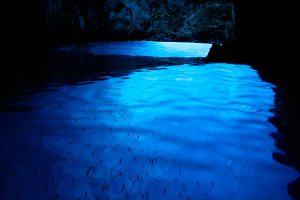 A stay in Split is not complete without an offshore excursion, whether half-day, full day or for a two-hour jaunt just to see the night sky and Split’s skyline from a distance. Other than their signature Blue Cave and Hvar Tour that takes you on one-day island hopping to five breathtaking destinations, Šugaman Tours have an innovative line-up of special event tours up their sleeve.
A stay in Split is not complete without an offshore excursion, whether half-day, full day or for a two-hour jaunt just to see the night sky and Split’s skyline from a distance. Other than their signature Blue Cave and Hvar Tour that takes you on one-day island hopping to five breathtaking destinations, Šugaman Tours have an innovative line-up of special event tours up their sleeve.
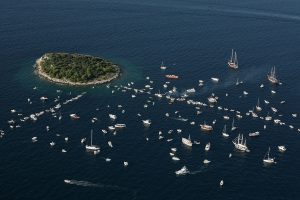 On August 12th and 13th, the Perseid meteor shower will animate the night sky above Split and with The Night of the Shooting Stars tour, you will be jetted away into the darkness beyond town for 1.5 hours to see a sparkling display of shooting stars in the night sky as you nibble on Dalmatian finger food and sip on Croatian sparkling wine.
On August 12th and 13th, the Perseid meteor shower will animate the night sky above Split and with The Night of the Shooting Stars tour, you will be jetted away into the darkness beyond town for 1.5 hours to see a sparkling display of shooting stars in the night sky as you nibble on Dalmatian finger food and sip on Croatian sparkling wine.
Alternatively, you can experience Split’s island archipelago by day with a special edition of their otherwise famed Blue Lagoon Tour on July 25th, when the nearby islands of Brač and Šolta take part in the traditional Tugging of Island Mrdulja.
From landmark explorations in Diocletian’s Palace and wandering outside its fortified walls, to discovering the Adriatic wonders beyond the bay, Split is blessed with its relatively small size making it possible to put together a fun-packed itinerary without missing a thing.
Inside the National Wonder
One of the most unique natural phenomena in the world, the Blue Cave on island Bisevo will be a highlight of your holiday. With its silvery-blue color, created by light refraction of sunlight entering through a crack in the stone, it leaves nobody indifferent.
Swimming and Snorkeling Paradise
Since the Adriatic sea around the Croatian islands is always crystal clear the shallow water inside the lagoon is immaculately clear so you can easily see all the way to the bottom of the sea.
Gem of Croatian Tourism
Hvar town has a long and distinguished history as a center for trade and culture on the Adriatic.As one of the earliest tourist boards in Europe, it was founded in 1868 with the purpose of providing good care for visitors.
Split's Islands
With so many islands dotting the coastline, why not escape the urban jungle and discover the color spectrum of the crystal clear Adriatic? All in a day’s work, take the Blue Cave & Hvar Tour to explore a bright blue cave on Biševo Island, Green Cave on Vis, swim surrounded by towering cliffs in Stiniva Cove and observe the sandy seabed by Budikovac Island. Before returning to Split, soak up the last rays in Palmižana Bay and take a stroll amongst eight centuries of architecture in charming Hvar Town.
Split islands are also a perfect destinations for swimming and snorkeling enthusiasts. This is mainly due to their pristine sea, numerous secluded beaches and healthy sea cultures.
Tranquility of the islands
Croatia has more than 1000 islands dotting its long coastline and there is a collection of islands near Split that are the most pristine on the Dalmatian coast.
Discover Nearby National Parks
Split is a popular starting destination for visiting number of Croatian National Parks. National Parks are protected areas by law and are commonly determined by extreme natural beauties, endemic species and diverse plant and wildlife.
Most popular national parks visited from Split are Krka and Plitvice National Parks. Krka, the closer one, attracts visitors with its amazing landscape, opportunity to swim by the waterfalls and it unique educational ethno village.
Plitvice, on the other hand, is the unique natural area characterized by 16 interconnecting lakes, numerous waterfalls and most beautiful nature trails. It is also a home of the highest Croatian waterfall which is one of the most famous landmarks of the park.
Swim by the Waterfalls
One of the most remarkable natural landmarks in Croatia is Skradinski buk, a waterfall system with travertine formations spreading over 800 meters in length. It is the top attraction of Krka National Park.
Roar of the Highest Waterfall
The lakes are beautiful at every time of the year, but during the spring, summer and early autumn, the vegetation makes the place spectacular. Many people prefer to visit the park on a hot summer’s day to enjoy the cool breeze created by the splashing water.


